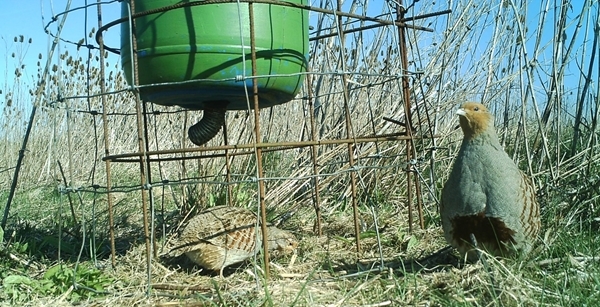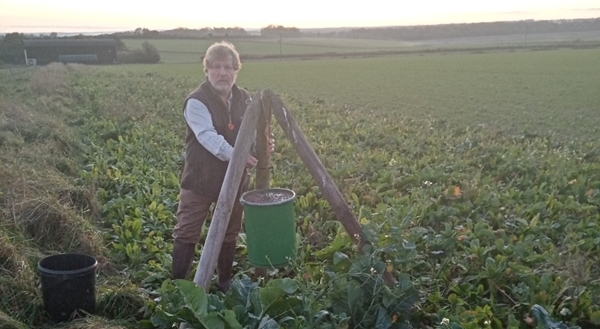
Why feed gamebirds after the shooting season?
The leanest time for gamebirds are the late winter and early spring months. By January most of the harvest-spilt grain and weed seeds have been gleaned by birds and small mammals, leaving only green shoots and leaves for gamebirds to feed on.
Once the shooting season finishes, feed hoppers are often allowed to run out, leaving gamebirds, which have been used to being well fed, with a potential shortage of food. Table 1 (see below) shows the results of dissections of several hundred crops of wild grey partridges in the 1930s. It clearly shows how little grain and weed seeds are left by late winter and this was at a time when agriculture was far less efficient than it is today.

When looking at this table it should be noted that one gram of wheat provides the dry weight food value of 24 pecks of green leaves! Getting enough food quickly enables gamebirds to maintain condition, to have more time to watch out for predators and, because they are in good condition, react to a potential attack faster.
Research has shown that gamebirds lose weight and condition during these lean months so that come the breeding season in April and May, when hen birds have to produce and incubate eggs, and when this causes them to lose weight naturally, many are simply not in good enough condition to breed successfully.
The Game & Wildlife Conservation Trust has shown in extensive feeding trials that when pheasants are fed wheat in their breeding territories, the density of territorial cocks and hens can increase by up to 50%. Fed hens can maintain body condition throughout the nesting period and, if they lose a nest, are much more likely to re-nest compared with unfed birds. On average, around 85% more chicks are produced to fledging when spring feeding is employed.
In the Aisne region of northern France, Jacques Hicter has developed and successfully put into practice a feeding system for wild grey partridges. He has managed to achieve spring populations of 80 pairs per 100 hectares and, perhaps even more encouragingly, has inspired up to 50 other land managers to follow his lead.
There are some differences between feeding partridges and pheasants so this guide has dealt with each separately. However, both partridges and pheasants often feed from the same hopper, as indeed do many small birds such as yellowhammers and corn buntings.
Feeding pheasants
After the shooting season, identify good nesting areas. These are usually shrubby, scrubby areas beside woodland edges or rides within woods; also by hedges, with tussocky grass margins and field corners. Place feed hoppers beside them.
Late winter/spring feeding areas may be different from the winter feeding sites as the latter may be unsuitable for nesting. Hoppers should be spaced at intervals, 50 to 75 metres apart. Many small hoppers are better than few large ones, as they encourage birds to spread out, which stops dominant cocks from keeping large feed hoppers to themselves.
The type of hopper to choose will vary depending on your preference, but is usually 25-50 litres capacity with slits in the base or a spiral attachment. Pheasants use either style, although non-game species such as rats and squirrels can access grain more easily from the spiral system. The height of the hopper should be set 40-45 centimetres (16”-18”) from the ground.
We consider wheat to be the best grain with which to fill hoppers, as trials have shown that pheasants prefer it to other cereals. However, we have yet to test other supplemental feeds. Ideally the hoppers should be checked and filled regularly and not allowed to run out until at least mid-June.
Feeding grey partridges
Hoppers for grey partridges should be put out well before the coveys split up (often in December in mild winters). They should be placed near suitable nest sites such as tussocky grass margins, either on their own or next to a fence, wall or hedge. Divisions between crops and beetle banks are also good places.
Put out at least one feeder per pair that you expect to see. If in doubt, place one where you see partridges regularly or where you thought they may have nested previously.
It is also advisable to put out extra hoppers, as they may attract pairs into your area. Research shows that hoppers help to ‘fix’ pairs of grey partridges and there is a strong link between hopper position and nest site, usually within 20 metres.

The hopper itself should be between 20-40 litres in size and set at a height of around 20-25 centimetres (8”-9”) from the ground. Wheat is the ideal grain to fill them with. As with pheasants, wheat is currently our recommended feed until we test alternatives. French keepers often cover them with fir branches, which may offer some protection from predators. It is also helpful in finding the hopper again once the crop has grown up around it – hoppers and fir branches are not ideal materials for the combine!
Many keepers, including the Game & Wildlife Conservation Trust’s Malcolm Brockless, have designed their own cage-like structure around the hopper (see picture). This seems to help keep raptor predation to a minimum. Crows and jackdaws can sometimes take a lot of grain from hoppers, but weldmesh structures help to stop many of them as well – they are too suspicious to enter.
It doesn’t, however, seem to stop partridges once they have become accustomed to it. Mesh (size 20x20cm or 8”x8”) keeps both deer and badgers at bay - both can be extremely destructive. If the structure is also supporting the hopper (as in the picture) it can easily be moved to keep the ground beneath it ‘clean’.
Each time the hopper is moved any rat holes can be baited to reduce their numbers. Hoppers should be kept full until the end of May and then slowly allowed to run out. However, in France a year-round hopper system is employed and feeders can be seen out on the stubbles even after harvest.
- Download the GWCT Guidelines for successful gamebird and songbird feeding >
Rat control at feed hoppers
Follow runs from hoppers back to the holes where rats are living. Anticoagulant rat poisons can be used. As meal-based poisons spoil easily, it may be easier to use block baits. These should be pushed down the holes, which should then be sealed. Check daily for holes being re-opened, and top up and re-seal as appropriate. Also, check the local area for dead rats. These, and bait remains, should be cleared up and burnt or buried deeply to minimise the risk of secondary poisoning.